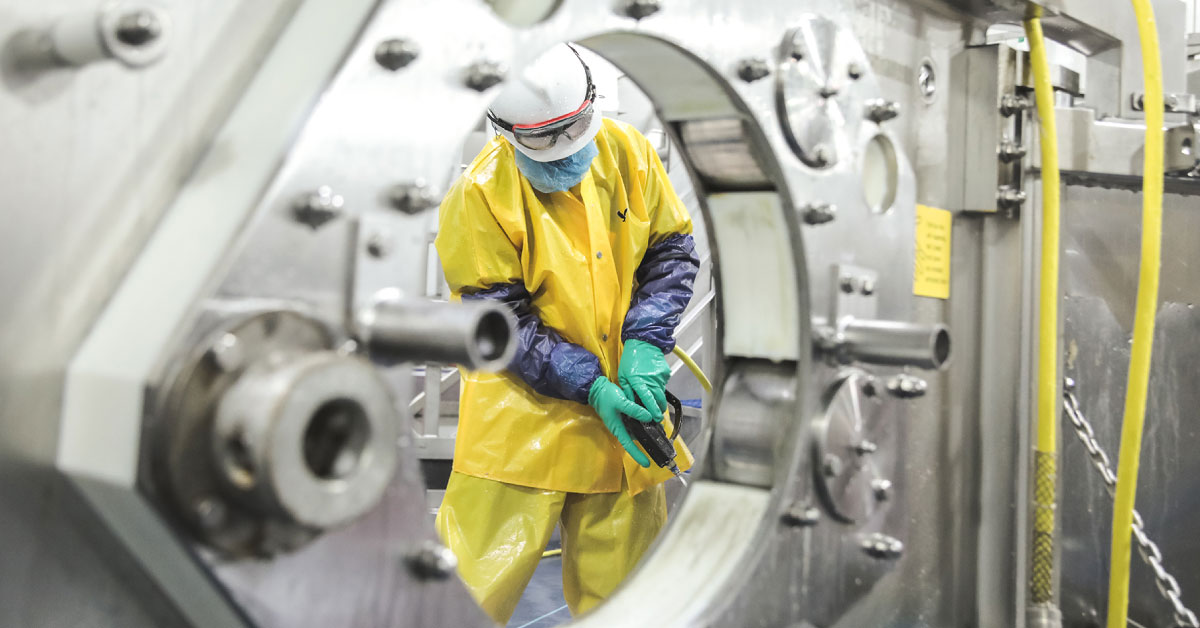In the pursuit of a clean, compliant plant with minimal disruption, plant managers often turn to specialized contract sanitation partners. While in-house sanitation may seem cost-effective, it brings high stress, oversight demands, and safety risks. To assess the true cost of plant sanitation, managers must consider the broader food safety landscape, beyond direct labor and chemical expenses. Overlooking these indirect costs can significantly impact productivity and profitability. Contract sanitation offers a comprehensive solution, mitigating risks and ensuring consistent compliance.
Think beyond just labor and chemical costs and consider the variety of indirect costs related to sanitation. These are costs that play a vital role in your overall productivity, profitability and protection. While you may not consider these indirect costs on a daily or monthly basis, you should. Because they are potentially critical threats to your plant’s overall performance.
Sanitization and Safety Equipment: Plant sanitation requires a wide array of cleaning and personal protective equipment (PPE), including items mandated by OSHA and company policies such as uniforms, eye and ear protection, gloves, and chemical dispensing equipment. OSHA’s requirement for a specific PPE support program adds to the financial burden, with additional labor costs needed to manage equipment and ensure compliance. Despite their necessity, the true costs of acquiring and maintaining this equipment are often overlooked when comparing sanitation options.
Downtime: Inefficient sanitation processes contribute to delays and interruptions in production, resulting in significant losses in revenue and productivity. Downtime not only results in direct costs from the loss of production and product sales opportunities but also incurs significant costs from idle labor. Contract sanitation partners often offer reimbursement for direct idle labor costs related to sanitation issues, making them a valuable consideration.
Machinery and Equipment Damage: Improper handling during sanitation shifts can lead to costly damage to vital processing machinery, amplifying financial liabilities. Water or chemical damage to electrical components or incorrect disassembly/assembly of food processing machinery can incur substantial repair or replacement costs, impacting the overall operational efficiency and profitability of the plant. The associated cost of any machinery issue that arises under the management of an in-house sanitation team is generally liability placed on the plant. On the other hand, best-in-class contract sanitation and food safety partners typically take full responsibility for covering the related costs of any machinery or equipment damaged by their workers during a sanitation shift.
Workers’ Compensation and Risk Management: With a lost-time injury rate more than twice as high in food processing facilities, and sanitation work being especially hazardous due to the use of dangerous chemicals and complex equipment, ensuring the safety of every individual in the facility is important. The financial repercussions of workplace injuries, ranging from minor strains to life-altering injuries, are significant, encompassing direct costs like downtime and insurance premiums, as well as indirect costs like decreased employee morale and brand reputation damage. Assessing safety programs, history, and coverage when considering contract sanitation partners is essential for mitigating these risks and safeguarding both employees and the business.
Technology and Reporting Trends: Evolving regulatory requirements demand advanced technology and expertise for accurate documentation. Compliance with regulations like FSMA demands meticulous record-keeping to trace sanitation issues and respond promptly to concerns. Adherence to best practices and effective follow-through are essential to avoid fines or shutdowns. However, without the right technology and expertise, reporting can be overwhelming for plant managers. Utilizing the right technology enables real-time tracking of Key Performance Indicators (KPIs), enhancing the overall effectiveness of sanitation efforts and ensuring food safety standards are met consistently.
Employee Recruiting and Specialized Support: Plant managers often face challenges in recruiting and retaining qualified employees, especially in today’s tight labor market. High turnover rates and unreliable staff not only consume time and resources but also lead to disruptions and stress in daily operations. In contrast, partnering with a contract sanitation provider alleviates the burden of recruitment and training costs while ensuring access to a team of experts in various specialized areas such as chemistry, engineering, and microbiology. This expert support is crucial for effective food safety and sanitation, minimizing the risk of issues like Listeria outbreaks and ensuring compliance with regulations. By contracting out sanitation to experienced professionals, plant managers can focus on core business activities.
The decision between insourcing and outsourcing sanitation hinges on the understanding of associated costs. While in-house solutions may appear cost-effective at first, the hidden expenses and risks highlight the value of partnering with contract sanitation experts. By uncovering and quantifying the six hidden costs outlined above, food processors can make informed decisions to ensure plant safety, compliance, and long-term financial viability.
